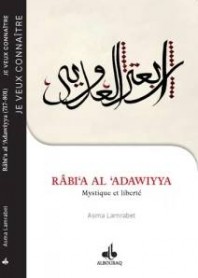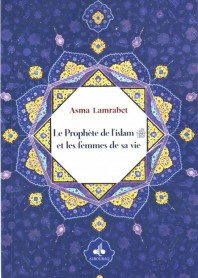Maryam and the myth of “the male is not like the female.”
Maryam and the myth of “the male is not like the female.”
Asma Lamrabet
September 2015
The story of Maryam’s birth as related by the Qur’an begins with an invocation by her mother who is named imra’atu ‘Imran “the wife of ‘Imran”. Maryam’s mother, also known as Hannah by Muslim historians or Anne according to the Christian tradition,[1] is described as a fervent believer. At the end of a long barrenness and numerous supplications to her Creator, she finally saw her desire to give birth fulfilled at an advanced age. Stunned by joy at the announcement of her deeply yearned for pregnancy, she made a vow of consecration of the future child to God, as a mark both of her recognition and her infinite gratitude. The Qur’an describes the episode in the following way:
“’Imran’s wife said, ‘Lord, I have dedicated what is growing in my womb entirely to You; so accept this from me. You are the One who hears and knows all,’” Qur’an 3:35
Hannah, a deeply religious woman, ardently wished to offer her future child to God. Translated into the language of the time, it was tantamount to saying that the child would be fully devoted to the service of the sacred Temple. Indeed, according to tradition, the Jewish rite allowed the possibility of dedicating young children, as early as their birth, to the service of the Sanctuary, but only boys because – also according to custom – the menstruation of girls was considered as a source of impurity. Throughout time and human history it is evident that discrimination against the female gender has been a common occurrence and is further visible within the domain of the sacred, mistakenly considered as a male prerogative by divine order. According to the logic of the existing customs, to undertake her commitment, Hannah had to bear a son who would fulfil this religious mission specifically assigned to the most virtuous of men. She therefore dreamt of seeing her future child amongst God’s faithful; amongst the chosen ones of the city. She wanted her child to be muharraran, i.e. liberated and emancipated from the enslavement of this lower world. The Qur’anic exegesis, both classical[2] and mystical, expresses Hannah’s aspiration of seeing her future child liberated from the dependence on base passions and liberated from the demands of his carnal soul.
She desired him to be fully devoted to the love of God, to His obedience and at the service of His friends, His worshippers, those who lived in the Sacred House.[3] This interpretation concurs with that of Sayyid Qtub, who describes Maryam’s mother as a pious soul, who by offering the fruits of her womb to her Creator, gave us at the same time a beautiful lesson on human liberation. She wanted him liberated from everything but HIM. It is a perfect translation of the submission to God, the sublime image of the deep commitment to the principle of the oneness of God or tawhid.
But imagine her surprise at the birth of her child when she realized that God had granted her a daughter. How could it possible for a girl to fulfil this religious function, the exclusive preserve of the male gender? Hannah, initially, appears somewhat disappointed to have given birth to a daughter. The Qur’an recounts her thinly veiled sadness at having “a poor girl” while she had promised to dedicate her future child, a boy as one might expect, to the religious consecration of the time. Distraught, she finds herself apologizing before her Lord:
“But when she gave birth, she said, ‘My Lord! I have given birth to a girl’ - God knew best what she had given birth to: the male is not like the female (wa laysa adh-dhakaru kal unthâ). ‘I name her Mary and I commend her and her offspring to Your protection from the rejected Satan.’” Qur’an 3:36
Hannah was therefore saddened but above all she was fearful of having disappointed her Creator and of not being able to fulfil her promise. But through her sad disillusion, one can perceive a feeling of latent revolt towards the injustice of this discriminatory practice; a bitter assessment expressed to God in the guise of a personal lament: “The male is not like the female.” Hannah denounced the established social order that prevented girls from accessing this religious power! In this intimate interview with God, Hannah laments, beseeches and confides in her Creator. She wants to believe until the very end that her vow of consecration can be fulfilled even with a daughter! She begs God to accept her and to preserve her: “I name her Mary and I commend her and her offspring to Your protection”. In the language of the time, “Maryam” meant “pious person” or “servant of God”.[4] Hannah was expressing through this forename her determination but also her trust in the divine answer.
The classical exegesis attributes the verse “God knew best what she had given birth to” to God Himself, who answers Hannah’s lament with the assurance that the daughter He had granted her, was actually infinitely better than the boy she had hoped for, and that the future in store for her daughter was far from what she predicted for the long-awaited boy![5] Hannah’s wish was fulfilled and God asserts in the following verse:
“Her Lord graciously accepted her and made her grow in goodness […]” Qur’an 3:37
Despite the fact that the status of muharraran or that of “consecration” at the holy Temple was exclusive to boys, God chose a girl and granted her this coveted religious privilege normally bestowed on the chosen men of the time. God had therefore explicitly elected a girl to remedy this discriminatory situation and to demonstrate to human beings, regardless of their epoch, that ultimately it was not a matter of gender but rather of virtue and piety. And Maryam was unquestionably the figure who personified the universal reference to this human piety, much to the amazement of her contemporaries and many other people throughout history.
Some Muslim commentators and thinkers have, however, removed the verse, “The male is not like the female” (wa aysa adh-dhakaru kal untha) from its historical context imposing on it an interpretation that contradicts its intended meaning according to the Qur’an.
While the issue was, as previously mentioned, to correct an injustice and therefore to abolish the sexist tradition of the time, some have used this verse as justification to endorse, religiously speaking, the supposed supremacy of men over women![6] While the divine purpose was absolutely clear, in other words, to correct or even to contest an unjust custom, some interpreters have remained frozen in an unfortunate cultural misogyny and claim that this verse is a divine affirmation of men’s superiority over women.
Most alarmingly the argument made by the latter borders on the laughable, if not ridiculous as some explain women’s inferiority - supported, according to them, by the same verse – on the grounds that during the month of Ramadan women are not required to make up the days of fasting, when sexual relations - normally forbidden when fasting - have occurred during the day, while men are under obligation to make up their days in the same circumstances![7] One cannot see either the connection or the logic of such an assertion, but the sad reality is that it is repeated in black and white throughout the texts of classical exegesis! Other interpreters, while also attempting to justify male superiority, become ensnared within the eternal justifications of menstruation and psychological transformations which according to their viewpoints, make women biologically inferior, or even incomparable to men, who have been spared from all of these human impurities. Biological and natural difference here is confused with pre-eminence and supremacy. Incidentally, the difference from a biological perspective forms the main argument of those advocating the inequality between women and men.
Man and woman are admittedly distinct in their physical makeup but this does not imply the superiority of one over the other. This view is undoubtedly differentialist but is in no way discriminatory. To be a woman or a man is to be other without being inferior in relation to the other; the recognition of the right of equality is inseparable from the right to be different.
We can see here how the interpretation of the verse, intended to rectify a tradition of injustice towards women, ironically becomes the pretext for customary discrimination that pretends to be faithful to the principles of Islam.
Through the narrative of Maryam’s birth, God celebrates womanhood on two counts. Firstly, by fulfilling the wish of her mother, a devout believer, who during an intimate supplication to her Lord, does not bridle at deploring a contemporary sexist custom; and then, by guaranteeing to her daughter Maryam the role of the chosen-woman. Mother and daughter are two women who find themselves honoured and fulfilled by their Creator.
By beseeching the Creator to accept her daughter amongst the liberated human beings, Hannah has transmitted a hymn of deliverance to the whole of humankind. Maryam was to be born liberated from all constraints and through her liberation, God conveys a message to all women and men to free themselves from all forms of bondage. This is unquestionably the profound meaning of the Islamic vision of human liberation.
[1] No text in the New Testament mentions the name of Anne. She appears for the first time in the Apocrypha, the Protevangelium (or Gospel) of James.
[2] Tafsir, Ibn Kathir, At-Tabari, al-Qurtubi...
[3] Sahl al Tustari, Tafsir al-Qur’an al-Azim in the study by Pierre Lory.
[4] Tafsir al-Qurtubi.
[5] Az-Zamakhshari, Al Kashaf.
[6] See the related commentaries by al-Ghannoushi; referenced above; p.26.
[7] Tafsir al-Qurtubi.
À propos de l'auteur

ASMA LAMRABET
Native de Rabat (Maroc), Asma Lamrabet, exerce actuellement en tant que médecin biologiste à l’Hôpital Avicennes de Rabat. Elle a exercé durant plusieurs années (de 1995 à 2003) comme médecin bénévole dans des hôpitaux publics d'Espagne et d’Amérique latine, notamment à Santiago du Chili et à Mexico.






